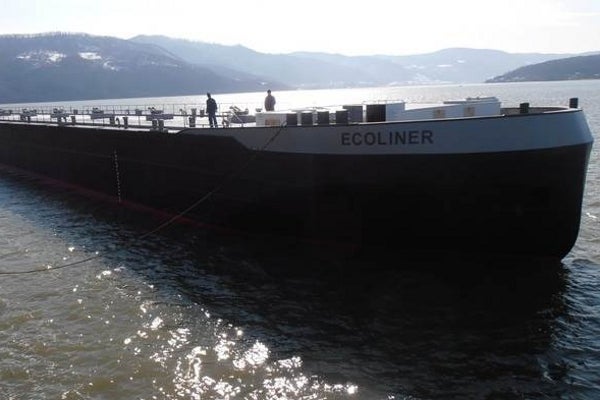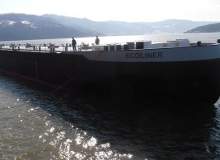
EcoLiner is an LNG-powered inland shipping tanker being built by Damen Shipyards Group for use in inland waterway shipping operations. The first EcoLiner tanker was launched in February 2015 at Damen’s shipyard in Romania and is scheduled for delivery in mid-2015.
The vessel was developed as part of the EU-supported LNG Masterplan for the Rhine-Main-Danube project, which is funded through the TEN-T programme by the European Union.
The EcoLiner inland shipping tanker concept was unveiled by Damen’s Bodewes Binnenvaart inland waterway shipyard and QaGroup in September 2012. The vessel is built at Bodewes Binnenvaart shipyard, while Damen Shipyards Hardinxveld managed the project.
The inland shipping tanker is based on the Damen River Liner 1145 ship and is classified by Bureau Veritas. Its modular design can be configured for transportation of containers and dry bulk. The vessel provides up to 25% of fuel savings.
Design, features and capacities of Damen EcoLiner
The EcoLiner inland LNG-fuelled waterway tanker features the Air Chamber Energy Saving (ACES) air lubricated hull, which provides up to 15% fuel reductions based on speed and weight parameters.
The tanker measures 110m in overall length, 11.45m in breadth and 5.75m in depth. It has deadweight of 2,600t at 3.30m and a cargo tank capacity of 3,770m³. The airdraft and maximum draft of the vessel are 4.65m and 3.65m respectively.
The vessel is capable of carrying 55m³ of gas, 14m³ of freshwater, approximately 2m³ of lubricating oil and 2m³ of dirty oil. It is fitted with 100m³ ballast tanks at the aft, 1,390m³ ballast tanks in the middle section, and 120m³ ballast tanks at the front.
It is further equipped with three 1,150kg anchors, FM200 / Novec fire-fighting equipment, self priming centrifugal pumps, and an optional waste heat recovery system. It also features a large wheelhouse with a lowerable top part.
The vessel is fitted with up to ten cargo tanks with a capacity of 377m³ each, two 28m³ slop tanks, a galvanised piping single part cargo system, and two Kampers 2C232 / 100LHE cargo pumps with an unloading rate of 500m³/h each.
Accommodation aboard the Damen Ecoliner
The forward hull of the EcoLiner inland shipping tanker accommodates a kitchen or messroom, bathroom and three bedrooms. Accommodation facilities at the aft section include entrance, messroom with kitchen, hall, toilet, bathroom and three bedrooms.
Navigation and communication systems aboard the LNG-fuelled tanker
Each of the twin Damen 8000 tankers has ten epoxy-coated cargo tanks with five segregations and fixed tank-cleaning systems.
The EcoLiner is equipped with one Type River radar, two VHF mariphones, Tresco chartplotter; and combi pilot, intercom and echosounding systems from Radio Zeeland / Alphatron.
It also incorporates an advanced automatic identification system (AIS) developed by Shiptron for increased navigational safety. A Nufatron type NT-01 tachograph is fitted to automatically record speed and distance of the vessel.
Propulsion system of EcoLiner
The propulsion system consists of four LNG-fuelled generator sets of 280kW each, a 400kW channel bow thruster, two 500kW Z-drive or Pod thrusters, and high-efficiency nozzle propellers. The electrical equipment onboard includes 230V / 400V / 480V, 50Hz / 60Hz and 24VDC systems. The vessel is fitted with a steering gear.
A retractable Van der Velden FLEX tunnel is installed in the vessel to ensure sufficient water supply to the propellers and increases their efficiency when navigating in shallow waters. The propulsion system enables the EcoLiner to sail at a maximum speed of 10.8kt.








